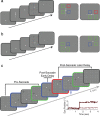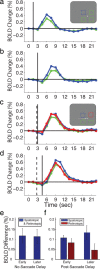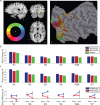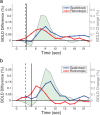Attentional facilitation throughout human visual cortex lingers in retinotopic coordinates after eye movements
- PMID: 20685992
- PMCID: PMC2925081
- DOI: 10.1523/JNEUROSCI.1546-10.2010
Attentional facilitation throughout human visual cortex lingers in retinotopic coordinates after eye movements
Abstract
With each eye movement, the image of the world received by the visual system changes dramatically. To maintain stable spatiotopic (world-centered) visual representations, the retinotopic (eye-centered) coordinates of visual stimuli are continually remapped, even before the eye movement is completed. Recent psychophysical work has suggested that updating of attended locations occurs as well, although on a slower timescale, such that sustained attention lingers in retinotopic coordinates for several hundred milliseconds after each saccade. To explore where and when this "retinotopic attentional trace" resides in the cortical visual processing hierarchy, we conducted complementary functional magnetic resonance imaging and event-related potential (ERP) experiments using a novel gaze-contingent task. Human subjects executed visually guided saccades while covertly monitoring a fixed spatiotopic target location. Although subjects responded only to stimuli appearing at the attended spatiotopic location, blood oxygen level-dependent responses to stimuli appearing after the eye movement at the previously, but no longer, attended retinotopic location were enhanced in visual cortical area V4 and throughout visual cortex. This retinotopic attentional trace was also detectable with higher temporal resolution in the anterior N1 component of the ERP data, a well established signature of attentional modulation. Together, these results demonstrate that, when top-down spatiotopic signals act to redirect visuospatial attention to new retinotopic locations after eye movements, facilitation transiently persists in the cortical regions representing the previously relevant retinotopic location.
Figures








Similar articles
-
Attention doesn't slide: spatiotopic updating after eye movements instantiates a new, discrete attentional locus.Atten Percept Psychophys. 2011 Jan;73(1):7-14. doi: 10.3758/s13414-010-0016-3. Atten Percept Psychophys. 2011. PMID: 21258903 Free PMC article.
-
A retinotopic attentional trace after saccadic eye movements: evidence from event-related potentials.J Cogn Neurosci. 2013 Sep;25(9):1563-77. doi: 10.1162/jocn_a_00390. Epub 2013 Mar 26. J Cogn Neurosci. 2013. PMID: 23530898
-
Robustness of the retinotopic attentional trace after eye movements.J Vis. 2010 Mar 31;10(3):19.1-12. doi: 10.1167/10.3.19. J Vis. 2010. PMID: 20377296 Free PMC article.
-
Human cortical areas underlying the perception of optic flow: brain imaging studies.Int Rev Neurobiol. 2000;44:269-92. doi: 10.1016/s0074-7742(08)60746-1. Int Rev Neurobiol. 2000. PMID: 10605650 Review.
-
Visual attention and stability.Philos Trans R Soc Lond B Biol Sci. 2011 Feb 27;366(1564):516-27. doi: 10.1098/rstb.2010.0187. Philos Trans R Soc Lond B Biol Sci. 2011. PMID: 21242140 Free PMC article. Review.
Cited by
-
Brain circuits underlying visual stability across eye movements-converging evidence for a neuro-computational model of area LIP.Front Comput Neurosci. 2014 Mar 11;8:25. doi: 10.3389/fncom.2014.00025. eCollection 2014. Front Comput Neurosci. 2014. PMID: 24653691 Free PMC article.
-
The Development of Selective Attention Orienting is an Agent of Change in Learning and Memory Efficacy.Infancy. 2016 Mar 1;21(2):154-176. doi: 10.1111/infa.12100. Epub 2015 Aug 14. Infancy. 2016. PMID: 26957950 Free PMC article.
-
Eye movements disrupt EEG alpha-band coding of behaviorally relevant and irrelevant spatial locations held in working memory.J Neurophysiol. 2023 May 1;129(5):1191-1211. doi: 10.1152/jn.00302.2021. Epub 2023 Mar 29. J Neurophysiol. 2023. PMID: 36988227 Free PMC article.
-
Predictive remapping leaves a behaviorally measurable attentional trace on eye-centered brain maps.Psychon Bull Rev. 2021 Aug;28(4):1243-1251. doi: 10.3758/s13423-021-01893-1. Epub 2021 Feb 25. Psychon Bull Rev. 2021. PMID: 33634356
-
Transsaccadic integration is dominated by early, independent noise.J Vis. 2019 Jun 3;19(6):17. doi: 10.1167/19.6.17. J Vis. 2019. PMID: 31206139 Free PMC article.
References
-
- Andersen RA, Snyder LH, Bradley DC, Xing J. Multimodal representation of space in the posterior parietal cortex and its use in planning movements. Annu Rev Neurosci. 1997;20:303–330. - PubMed
-
- Awh E, Anllo-Vento L, Hillyard SA. The role of spatial selective attention in working memory for locations: evidence from event-related potentials. J Cogn Neurosci. 2000;12:840–847. - PubMed
-
- Brainard DH. The psychophysics toolbox. Spat Vis. 1997;10:433–436. - PubMed
-
- Bridgeman B, Van der Heijden AHC, Velichkovsky BM. A theory of visual stability across saccadic eye movements. Behav Brain Sci. 1994;17:247–257.
Publication types
MeSH terms
Grants and funding
LinkOut - more resources
Full Text Sources
